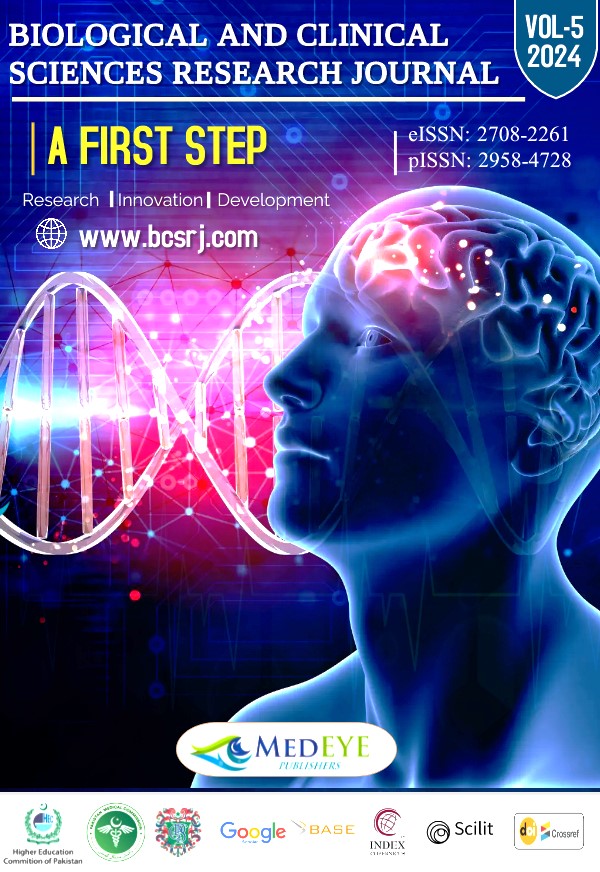KNOWLEDGE ATTITUDE AND PRACTICE REGARDING NEEDLE STICK INJURY AMONG NURSES IN THE TERTIARY CARE HOSPITAL OF LAHORE
DOI:
https://doi.org/10.54112/bcsrj.v2024i1.1484Keywords:
Needle Stick Injury, Staff nurses, Knowledge, Awareness, Pearson correlationAbstract
A Needle Stick Injury (NSI) occurs when a needle or other sharp object punctures the skin, potentially exposing the individual to blood-borne pathogens. Nurses are highly at risk of getting injured by sharp instruments. Objective: The study aims to assess nurses' knowledge, attitude, and practice regarding NSI and to find the correlation between these three parameters. Methods: This cross-sectional study was conducted at Sir Ganga Ram Hospital Lahore. In this study, 200 working nurses were included. A self-designed validated questionnaire was used. The software SPSS-23 was used to enter and analyze the data. Descriptive analysis was employed for summary statistics. Pearson’s correlation coefficient was used to investigate the relationship between variables. Results: Out of 200 nurses, 39 (19.5%) exhibited an experience of needle stick injury. A significant proportion (53.0%) of respondents were familiar with NSI, which causes wounds. Nurses have practices to utilize the hospital's resources to protect themselves from injuries. Significant relationships were found between all three domains (P<0.05).Conclusion: Based on these results, it is marked that while nurses possess an upright level of knowledge and show optimistic attitudes toward NSI prevention, to some extent, they require attention and improvement. Specific interventions and educational curricula are desirable to improve knowledge, attitudes, and practices, guaranteeing a better workplace, protecting healthcare personnel, and reducing the hazard of spreading blood-borne pathogens.
Downloads
References
Al-Khalidi GZS, Nasir NA. Knowledge, Attitude, and Practice Regarding Needle Stick Injuries Among Health Care Workers in Baghdad Teaching Hospital and Ghazy Al-Hariri Hospital for Surgical Specialties in 2020. Open Access Maced J Med Sci . 2022 Jul 2;10(E SE-Public Health Disease Control):1–7.
Tawiah PA, Appiah-Brempong E, Okyere P, Ashinyo ME. Exposure to needlestick injury among healthcare support staff in Greater Accra, Ghana: a cross-sectional study. BMJ Public Heal. 2024;2(1):e000681.
Kandeel A. Needle stick and sharp injuries ( NSSIs ) among housekeepers in a Saudi hospital : An intervention study. IjicInfo [Internet]. 1996;13:1–7. Available from: http://www.ijic.info/article/view/17329
King KC, Strony R. Needlestick. In Treasure Island (FL); 2024.
Cheetham S, Ngo HT, Liira J, Liira H. Education and training for preventing sharps injuries and splash exposures in healthcare workers. Cochrane database Syst Rev. 2021 Apr;4(4):CD012060.
Cooke CE, Stephens JM. Clinical, economic, and humanistic burden of needlestick injuries in healthcare workers. Med Devices (Auckl). 2017;10:225–35.
Mengistu DA, Tolera S, Demmu Y. Worldwide Prevalence of Occupational Exposure to Needle Stick Injury among Healthcare Workers: A Systematic Review and Meta-Analysis. Can J Infect Dis Med Microbiol. 2021 Jan 29;2021:1–10.
Sardesai R V, Gaurkar SP, Sardesai VR, Sardesai V V. Awareness of needle-stick injuries among health-care workers in a tertiary health-care center. Indian J Sex Transm Dis AIDS. 2018;39(2):107–10.
Handiyani H, Meily Kurniawidjaja L, Irawaty D, Damayanti R. The effective needle stick injury prevention strategies for nursing students in the clinical settings: a literature review. Enferm Clin [Internet]. 2018;28:167–71. Available from: http://dx.doi.org/10.1016/S1130-8621(18)30060-3
Setia MS. Methodology Series Module 3: Cross-sectional Studies. Indian J Dermatol. 2016;61(3):261–4.
Oakland GB. Determining Sample Size. Can Entomol. 1953;85(3):108–13.
Sharma R, Rasania S, Verma A, Singh S. Study of Prevalence and Response to Needle Stick Injuries among Health Care Workers in a Tertiary Care Hospital in Delhi, India. Indian J community Med Off Publ Indian Assoc Prev Soc Med. 2010 Jan;35(1):74–7.
Kebede A, Gerensea H. Prevalence of needle stick injury and its associated factors among nurses working in public hospitals of Dessie town, Northeast Ethiopia, 2016. BMC Res Notes. 2018 Jun;11(1):413.
Fadil RA, Abdelmutalab NA, Abdelhafeez SA, Mazi W, Algamdi S, Shelwy MM, et al. Pattern and risk factors of sharp object injuries among health care workers in two tertiary hospitals, Al Taif-Kingdom of Saudi Arabia 2016-2018. Saudi J Biol Sci. 2021 Nov;28(11):6582–5.
Suliman M, Al Qadire M, Alazzam M, Aloush S, Alsaraireh A, Alsaraireh FA. Students nurses’ knowledge and prevalence of Needle Stick Injury in Jordan. Nurse Educ Today. 2018 Jan;60:23–7.
Dafaalla MD, Kheir AEM, Hashim A, Mohammed N, Mirghani M, Haroon M, et al. Knowledge , attitude and practice towards needle stick injury among health care workers in a tertiary Sudanese hospital. 2016;3(1):1–9.
National Institute for Occupational Safety and Health (NIOSH). The NIOSH occupational exposure banding process for chemical risk management. Niosh [Internet]. 2019; Available from: https://www.cdc.gov/niosh/docs/2019-132/
Bezerra DF, Franklin Junior W, Spotorno P, de Almeida Rocha Barreira C. Molluscan assemblages on artificial structures: a bioinvasion perspective from Northeast Brazilian ports. Aquat Invasions. 2022;17(4):494–515.
Bhargava A, Mishra B, Thakur A, Dogra V, Loomba P, Gupta S. Assessment of knowledge, attitude and practices among healthcare workers in a tertiary care hospital on needle stick injury. Int J Health Care Qual Assur. 2013;26(6):549–58.
Amare Z, Sheng W, Hussien A, a D. Assessment Of Knowledge, Attribution And Practice Related To Nsis And Blood Exposure Among Health Care Workers In The Armed Forces Referral And Teaching Hospital, Addis Ababa, Ethiopia. Int J Adv Res. 2018 Apr 30;6:110–9.
Al-Mugheed K, Farghaly SM, Baghdadi NA, Oweidat I, Alzoubi MM. Incidence, knowledge, attitude and practice toward needle stick injury among nursing students in Saudi Arabia. Front public Heal. 2023;11:1160680.
Mahmood NHN, Hamzah NF. Factors influencing sharp injury reporting among healthcare workers in Hospital Melaka. In 2017. Available from: https://api.semanticscholar.org/CorpusID:201180246
Abuduxike G, Aşut Ö, Vaizoğlu SA, Cali S. Health-seeking behaviors and its determinants: A facility-based cross-sectional study in the Turkish republic of northern Cyprus. Int J Heal Policy Manag [Internet]. 2020;9(6):240–9. Available from: https://doi.org/10.15171/ijhpm.2019.106
Downloads
Published
How to Cite
Issue
Section
License
Copyright (c) 2024 S AKRAM , A MAQSOOD , N NASAR , M NAZ , N MAQBOOL

This work is licensed under a Creative Commons Attribution-NonCommercial 4.0 International License.








